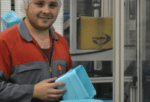Engineering Scholarship announced on International Women’s Day
“I feel alive every single day!” Charlotte Flaherty’s decision to leave full time work, and sign up for a Bachelor of Engineering Technology (Mechanical) took a lot of soul searching, and a long time to resolve. So she’s delighted with the news that she is Otago Polytechnic’s inaugural winner of the Women in Engineering Scholarship. “I gave up full time work to do this. My self-image and status was tied up with my job, and obviously, I’ve taken a drop in income, so winning this scholarship validates my choice. The 54 year-old has been a journalist at the Daily Telegraph in the UK, a Safer Journey Coordinator at the Dunedin City Council, and (is still) a mother of two. But after studying a couple of civil engineering papers five years ago, she got a taste for engineering. “I saved for three years for the fees, but I didn’t quite have enough, so this scholarship is just perfect.” Through the scholarship, Charlotte will receive $1000 towards her fees for each year of study. “I’m moderately geekish. I really want to speak fluent maths, and I have a real desire to understand how structures and systems work and react.” Charlotte’s no stranger to study. She has a CapableNZ degree in Business Transformation and Project Management. This was gained by studying part time while working full time. But she’s decided it’s time to focus solely on her education. “I am so happy – I’m absolutely loving the study. I really believe it’s the right choice and career move for me.”







